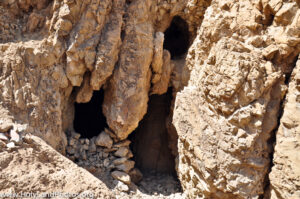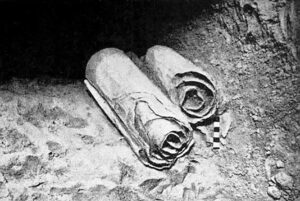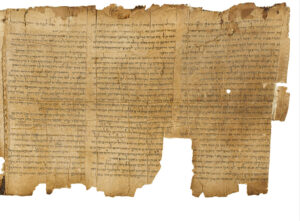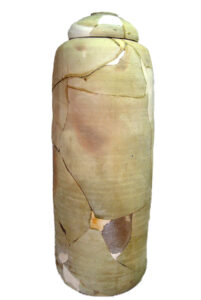By Dr. Don Bierle, FaithSearch President
This year, 2022, marks the seventy-fifth anniversary of the first Dead Sea Scroll discoveries in 1947, by some shepherds exploring caves on the northwestern shore of the Dead Sea. Subsequently, an amazing library of hundreds of scrolls and thousands of fragments were uncovered in eleven caves, with texts dating from the third century B.C. to the first century A.D.

The authors and copyists were in a settlement called Qumran. They consisted of Essenes, a Jewish sect of priests and laymen pursuing a communal life of strict dedication to God. They viewed themselves as the only true elect of Israel, and they alone were faithful to the Law. It is likely that they stored the scrolls in the caves in haste as they fled the Roman army, who were there to put down the Jewish Revolt in A.D. 67-70.
What’s the big deal about the Dead Sea Scrolls?
- After the Bible, the Dead Sea Scrolls are the most famous collection of writings from Israel
- Considered by many to be the greatest archaeological discovery of all time
- A library of nearly 1,000 scrolls, some complete and some with only fragments (20,000)
- Includes some text for thirty-eight of the thirty-nine Old Testament (O.T.) books, and are dated about 1,000 years earlier than the manuscripts used for the current O.T. Masoretic Text (the designated, authoritative Hebrew and Aramaic manuscripts of the twenty-four books of the Hebrew Bible).
What has been learned from the Dead Sea Scrolls?

- Prophecies in the O.T. (especially concerning Jesus) were not added to the Masoretic text later by Christians to feign fulfillment, as some had claimed. Since no O.T. manuscripts existed before the time of Jesus, Christians could not refute this accusation. However, the O.T. Dead Sea Scroll manuscripts date a century or two before the time of Jesus – and the Messianic prophecies are already there. For example, the New Testament (N.T.) links Jesus to both the prophecy of Isaiah 52:7, and the Suffering Servant of Isaiah 53 (which was claimed by critics to be a Christian addition). The two prophecies are already in the Isaiah scroll and the Qumran community linked the two as well. Their Messianic authenticity is established and confirmed!

- Transmission of the O.T. text over centuries by the scribes (human copyists) is demonstrated by the Scrolls to be incredibly accurate. One example, the complete Great Isaiah Scroll, when compared to the Masoretic text of Isaiah in our Bibles today, was nearly identical in content though it precedes the Masoretic text by about 1,200 years. Transmission accuracy established! The Great Isaiah Scroll is displayed today in the Shrine of the Book Museum in Jerusalem.
- The published Daniel materials from Qumran reveal a great harmony with the Masoretic text of Daniel. Thus the Hebrew-Aramaic text of Daniel (as in our current O.T.) can no longer be dismissed as unreliable (as critical scholars do). Also, since it was already considered canonical by about 100 B.C., it could not have been originally composed just a half century earlier (as critic scholars have proposed) but much earlier as has been traditionally held. The book of Daniel in our Bible now has stronger support than at any other time in its history because of the Dead Sea Scrolls.
The Dead Sea Scrolls and the New Testament
There is no evidence that any author of a N.T. book knew of or used any of the Dead Sea Scrolls. Moreover, the cast of characters in the Scrolls and in the N.T. is entirely different. No person mentioned in the N.T. (other than ones from the O.T.) appears in any of the Scrolls—not even John the Baptist, who for a time lived in the wilderness near the area of the Dead Sea Scroll caves (Luke 1:80; 3:3).
Moreover, the worldview is quite different. The N.T. view is to spread the Good News to all peoples to the ends of the earth. The Qumran community in contrast was seclusive without interest in sharing their message or bringing outsiders into the fold.

(Image courtesy: holylandphotos.org)
On the other hand, there seems to be some anticipation of important N.T. teachings (though with a flawed understanding). For example:
- Belief in the birth of a Wonderful Child:
In twelve small fragments, the expectation of the birth of a “Wonderful Child” is ascertained. It is possibly based on Isaiah 9:6-7: “For unto us a child is born, unto us a son is given… and his name shall be called Wonderful.” They said that this child would be remarkably wise, intelligent, bear special marks on His body, and inaugurate the new age for which the faithful fervently awaited. We have no way of knowing whether they ever discovered that not long after they composed this manuscript, a wonderful Child (Jesus) was born who indeed fulfilled the hopes of Israel and inaugurated a new age. - Belief in a coming Messiah:
It was in connection with their belief in end-time events that their messianic hope was expressed. Evidence shows that they actually looked forward to the advent of three people – a great prophet, a great prince (king), and a great priest. Their concept of Messiah was as a powerful militant, overthrowing the world system and establishing them in His kingdom of perfect obedience to the “works of the Law.” First, they did not understand that a single Messiah would come who fulfilled all three of these offices (Prophet: John 7:40; Acts 3:22; Priest: Hebrews 7:26; and King: Luke 1:32-33). Second, in His first coming as Prophet and Priest, He would manifest the grace of God by offering forgiveness for sins through His death on the cross. Third, only then this “Wonderful Child” (Jesus of Nazareth), having grown up and redeemed the world, would return as King to establish His perfect and eternal kingdom.
While the Qumran community was mistaken in their understanding of the “Child” and the “Messiah,” it is interesting to speculate whether they would have responded positively to a first century Christian who brought the truth about Jesus to them. Some day we will find out, not from the Dead Sea Scrolls, but from the “Son of the Most High” (Luke 1:32).
Sources: Dr. Craig Evans video interview on the Dead Sea Scrolls, Associates for Biblical Research (biblearchaeology.org); “The Dead Sea Scrolls: Past, Present and Future,” Biblical Archaeology Review Ebook.



